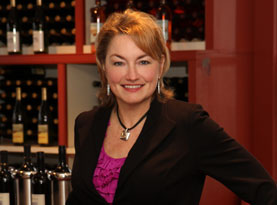First Year Results From Northern Grapes Project Announced
The Second Annual Northern Grapes Symposium featured first-year results from the USDA-funded Northern Grapes Project, which began in October 2011. Approximately 120 people attended three sessions of the Symposium, held on February 6, 2013 in Rochester, NY, in conjunction with the Viticulture 2013 Conference. Here are a few highlights:
Economic Impact. The emerging cold-climate grape and wine industry accounts for over $342 million in economic impact across 12 states, according to results from the Northern Grapes Project Year 1 Baseline Survey, presented by Dr. Bill Gartner of the University of Minnesota. The economic impact includes growing grapes, making wine from cold hardy varieties, and spending by tourists visiting the wineries. The cold climate grape industry is also experiencing rapid growth, with 43% of wineries specializing in the production of cold hardy wines established after 2007 and 45% of the northern grape cultivar acreage planted within the last four years.
Customer Satisfaction in Retail Tasting Rooms. Research in customer satisfaction by Dr. Miguel Gomez of Cornell University showed that converting tasting room customers from ‘satisfied’ to ‘extremely satisfied’ through excellent customer service sells more wine. A highly satisfied customer buys four bottles and spends $60 in a given visit, whereas a satisfied customer buys three bottles and spends $40. Therefore, tasting room managers should focus on friendliness and knowledge of the staff to enhance customer tasting room experiences.
Regional Wineries Improve Tourism Destinations. In a five month study of over 1,500 tasting room visitors by Drs. Dan McCole and Don Holecek of Michigan State University, 49% indicated that visiting wineries was either the ‘only reason” or a ‘very important reason” for visiting a tourism destination. The research further showed that the primary reasons people visit wineries are simply to have relaxing and unique experiences with friends and loved ones. Such experiences are apparently highly valued by wine tourists, as on average, tasting room visitors spend a total of $780 on their trips to destinations that offer wine tourism, further demonstrating the importance of wineries to tourism destinations.
Copper and Sulfur Sensitivity. Preliminary studies evaluating copper and sulfur phytotoxicity in Wisconsin and New York showed variable results, according to Dr. Patricia McManus of the University of Wisconsin. In Wisconsin, ‘Brianna’ was sensitive to copper and ‘Marechal Foch’ and ‘Leon Millot’ were sensitive to sulfur. In New York, all cultivars tested showed sensitivity to sulfur but not copper. However, as crop injury is highly dependent on environment, these studies must be repeated over years and locations before conclusions can be drawn.
Grapevine Nutrition. Studies looking at nutrient levels in soil and plant tissue were initiated in 16 sites spread across five states. Results from the first year of sampling, presented by Dr. Carl Rosen of the University of Minnesota, showed a wide range in soil types and nutrient levels. Tissue samples collected at three time points during the season also showed a wide range in nutrient concentrations, which will ultimately allow Dr. Rosen’s team to determine relationships between tissue nutrient concentrations, soil characteristics, and grape quality for northern grape cultivars.
Cultivar Trials. Yield of five selected cultivars (Frontenac, Frontenac gris, La Crescent, Marquette, and St Croix) varied across eight experimental variety trial blocks from North and South Dakota to Vermont and Massachusetts. Early budburst and subsequent frost injury reduced production, but also accelerated development, with harvests up to one month earlier than average. According to Dr. Tim Martinson of Cornell University, fruit composition at harvest was ‘…the best we could hope for from these cultivars, as they had ample time to ripen, and came in with lower acidity than what is typical.” At sites without frost injury, ‘Frontenac’ vines were able to ripen up to 27 lb of fruit per vine, with no reduction in sugars or increased acidity.
Yeast Selection for Northern Grape Cultivars. Enologist Katie Cook of the University of Minnesota presented results from yeast trials, which indicated that new yeast strains show promise for reducing the typically-high acidity levels in northern grape cultivars. Results showed that the malate degradation properties of promising strains of yeast can remove up to 23% of the malate found in the wine when compared to strains that do not have this property. Lalvin C and Anchor Exotics strains proved the most promising thus far for white grape cultivars Frontenac Gris and La Crescent.
Strategies for Acid Reduction. Combining new and traditional acid reduction strategies may result in the best wine quality, according to Cornell University enologist Dr. Anna Katharine Mansfield. Concurrent trials at Cornell University and the University of Minnesota are assessing the acid reduction capabilities of selected yeast strains and targeted chemical deacidificants, as well as their impact on broader wine sensory characteristics. Initial results suggest that different strategies are appropriate for different wine styles, and that a combination of acid-reducing yeast and post-fermentation additives may be the most effective way to reduce acid while maintaining optimal aromatic intensity.
Tannin Addition. Iowa State University enologist Dr. Murli Dharmadhikari is conducting research on phenolic composition of northern grapes and is studying the effect of tannin additions on red wine quality. The results showed that the cultivars Marquette and Frontenac contain relatively low levels of tannin and during maceration, only 46 to 52% of the tannins are extracted into final wine. Dr. Dharmadhikari discussed the strategy for maximizing tannin extraction and the possible benefits of enological tannin additions on red wine quality.
The Northern Grapes Project is a multi-institutional Coordinated Agricultural Project funded by the USDA’s Specialty Crops Research Initiative, with a multidisciplinary team from 12 universities in collaboration with winery and grape grower associations in ND, SD, MN, NE, IA, WI, IL, NY, VT, CT, and MA.


